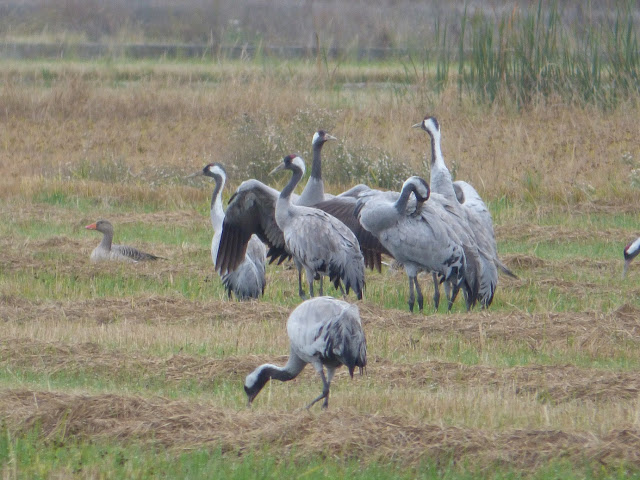Vanguard of grey
 |
| Recently arrived Common Cranes and Greylag Goose (Martin Kelsey) |
As I watched them, the silence was broken by brusque and insistent trumpeting as two more cranes approached, appearing to stroke the very air by their graceful, gentle shallow wingbeats. Four others were following some way behind. Against a morning sky of light cloud, again greyness was the tone. Over the next two hours as I slowly made my way across the fields, driving slowly for about twelve kilometres, I counted a total of 796 Common Crane. The grey vanguard had well and truly arrived. They were not my first cranes of this autumn. Since the 7th October, I had seen skeins passing south over the house. But this was my first day out at a key wintering area for them. After submitting my count to the coordinator of the Crane Working Group in Extremadura (a group of crane freaks to which I happily assign) I heard just minutes later than this had brought the total partially counted so far in the whole rice-growing area to over 14,000 birds). This suggests that the arrival this autumn has been earlier and stronger than usual, which others have remarked on too in a more anecdotal way.
There were other differences too from my last visit: a few Scandanavian Greylag Geese were also present with the cranes on the stubble fields, Bluethroats teased one with glimpses as I passed muddy ditches and Water Pipits were present on muddy margins.
The previous day I had returned too to the Alcollarín Reservoir, which I had also neglected over the last few weeks. On my way there from home, I crossed its namesake river, which for months had been nothing more than a strip of dry grey-dusty gravel. Water was now marking its course. The water-level of the reservoir itself looked as low as it had in late summer, but there were some immediately obvious differences. As I looked along the strandline, I searched in vain for parties of passage waders, indeed the only birds present there were a few Green Sandpipers. Spoonbills, Grey Herons, Great and Little Egrets were there as usual, but now many of the ducks on the open water were returning to full breeding plumage, especially so the Mallard (with almost a thousand birds present), although the dozing raft of Shoveler in the deep water near the dam were still mottled by eclipse. I made my way parallel to the western shore, pausing to watch a Firecrest in an encina, and reached a vantage point. A crowd of Common Coot scuttled off from the shore and headed into the water to the south-east of my position, hard to see against the sun. Looking in the other direction, there was a group of a dozen coot, a bit further away and seemingly oblivious to my presence. I repositioned myself, back to a tree to hide my outline and settled down to scan the water before me. The coot lured me, however, so I took a closer look at them. Quickly I noticed that one bird was different. Its bill was more bluish and appeared a bit longer and its white-shield above the bill seemed heart-shaped. Luckily the birds remained in good view for long enough for me to check other features to confirm my suspicions: sideways-on the shield met the base of the bill as a smooth curve rather than a deep inset and just about I could make out the reddish buds at the top of the shield itself (which produced the heart-shaped image): it was clearly a Red-knobbed Coot. This is a species that had not been recorded in Extremadura before 2008, but since 2012 it has been recorded annually with increasing sightings each year. These have been of marked birds (which had been bred in captivity and released as part of a reintroduction programme in elsewhere in Spain) as well as unmarked and presumably wild-bred birds. There had been an unmarked individual at Alcollarín last winter, as well as a sighting of a marked bird there in early spring.
 |
| Red-knobbed Coot (second from right) with Common Coot at Alcollarín (Martin Kelsey) |
This site never leaves me disappointed and as I left, a heavy female Peregrine flew along the shore, creating a surge of commotion amongst the waterfowl. I watched her until she disappeared behind the slope of the wooded hill beside me. She too had been checking out the joint.



Comments